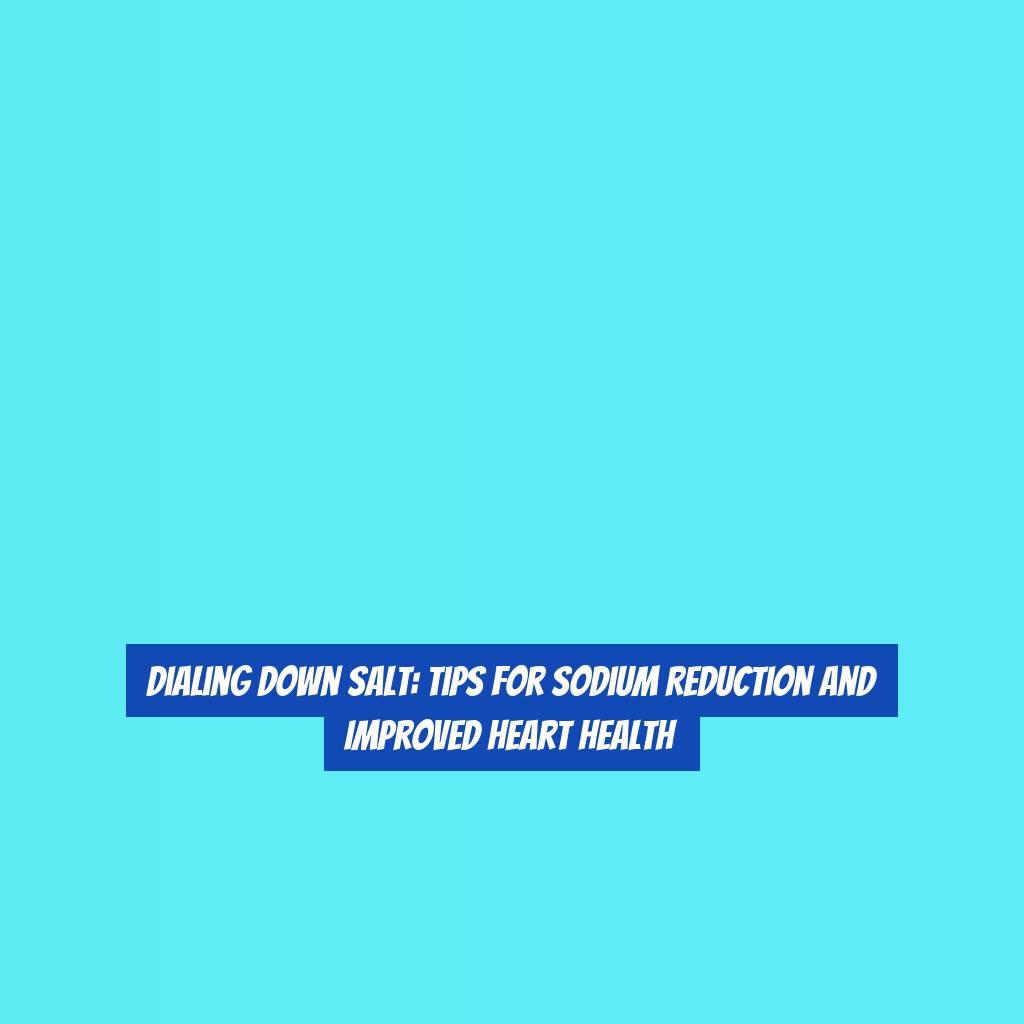Dialing Down Salt: Tips for Sodium Reduction and Improved Heart Health
You may not realize it, but the simple act of seasoning your food can have a significant impact on your heart health. While salt adds flavor, it also adds to the risk of high blood pressure and heart disease.
But fear not, there are practical and achievable ways to reduce your sodium intake without sacrificing taste. By making a few mindful adjustments to your eating habits, you can take control of your heart health and improve your overall well-being.
Understanding SodiumG??s Impact
To understand sodiumG??s impact on your heart health, itG??s essential to recognize its role in regulating fluid balance and maintaining healthy blood pressure levels. Sodium plays a crucial role in controlling the amount of fluid in your body. When sodium levels are high, your body retains water to maintain a balance, which can lead to increased blood volume and elevated blood pressure. High blood pressure, in turn, puts a strain on your heart and blood vessels, increasing the risk of heart disease and stroke.
ItG??s important to be mindful of your sodium intake because many processed and restaurant foods are packed with hidden sodium. By reducing your sodium consumption, you can help your body maintain a healthier fluid balance and lower your blood pressure. This proactive approach can significantly reduce the strain on your heart and decrease the risk of cardiovascular issues.
Being aware of sodiumG??s impact is the first step towards making positive changes for your heart health.
Identifying High-Sodium Culprits
You can identify high-sodium culprits by checking food labels and being mindful of common sources such as canned soups and processed meats. When youG??re trying to reduce your sodium intake, keep an eye out for the following high-sodium culprits:
-
Canned Soups: Many canned soups are packed with sodium to enhance flavor and preserve the ingredients. Opt for low-sodium or homemade soups to reduce your sodium intake.
-
Processed Meats: Deli meats, bacon, sausage, and other processed meats are often high in sodium. Look for lower sodium options or consider reducing your consumption of these products.
-
Condiments and Sauces: Sauces like soy sauce, teriyaki sauce, and condiments like ketchup and mustard can be surprisingly high in sodium. Check labels for lower sodium versions or use them sparingly to reduce your overall intake.
Smart Swaps for Lower Sodium Options
When looking for smart swaps to lower your sodium intake, consider choosing fresh or frozen fruits and vegetables over canned options. Fresh and frozen produce are naturally low in sodium and offer a wide range of nutrients that can benefit your heart health. Opt for fresh berries, leafy greens, carrots, and broccoli, or choose frozen varieties without added sauces or seasonings. This simple swap can help you reduce your sodium intake while increasing your intake of essential vitamins, minerals, and dietary fiber.
Another smart swap is to select fresh meats over processed or cured options. Fresh poultry, fish, and lean cuts of beef or pork contain less sodium than processed deli meats or cured bacon. When purchasing fresh meats, be mindful of how theyG??re prepared and opt for cooking methods that donG??t require additional salt.
Additionally, consider using herbs, spices, citrus juices, and vinegar to flavor your meals instead of reaching for the salt shaker. These flavorful alternatives can enhance the taste of your dishes without significantly increasing your sodium intake.
Dining Out With Sodium Awareness
Consider requesting nutritional information or asking about low-sodium options when dining out to make more informed choices for your heart health. When dining out, itG??s important to be mindful of your sodium intake to maintain a heart-healthy diet.
Here are a few tips to help you dine out with sodium awareness:
-
Choose grilled or steamed options: When ordering, opt for grilled or steamed dishes instead of fried or saut+?ed options. These cooking methods often require less added salt, reducing your overall sodium intake.
-
Ask for dressings and sauces on the side: Many dressings and sauces are high in sodium. Requesting them on the side allows you to control the amount you use, helping to lower your overall sodium consumption.
-
Inquire about low-sodium substitutions: DonG??t hesitate to ask your server if low-sodium substitutions are available. Many restaurants are willing to accommodate special dietary needs, and they may have alternative ingredients or cooking methods to reduce the sodium content of your meal.
Navigating Food Labels for Sodium Awareness
Transitioning from dining out with sodium awareness, navigating food labels for sodium requires attention to the sodium content in packaged and processed foods. When reading food labels, focus on the serving size and the amount of sodium per serving. Compare this to your recommended daily sodium intake, which is ideally less than 2,300 milligrams per day, or even less than 1,500 milligrams if you have high blood pressure, kidney issues, or are over 50 years old.
Look for the G??low-sodiumG?? or G??reduced-sodiumG?? labels on packaged foods, but donG??t be fooled by marketing tactics. Always check the actual sodium content to ensure it aligns with your dietary goals. Additionally, be wary of terms like G??unsalted,G?? G??no salt added,G?? and G??sodium-free,G?? as they donG??t necessarily mean low sodium.
Understanding the various names for sodium on food labels is crucial. Sodium can be disguised as monosodium glutamate (MSG), baking soda, baking powder, disodium phosphate, and sodium benzoate, among others. Being aware of these alternative names can help you identify hidden sources of sodium in your food.
Conclusion
So, now you know how to dial down your salt intake for better heart health.
By understanding sodiumG??s impact, identifying high-sodium culprits, making smart swaps, and being aware of sodium when dining out and reading food labels, you can make positive changes for your health.
ItG??s all about small, manageable steps that add up to big benefits for your heart.
Keep up the good work and enjoy the healthier, lower-sodium options available to you!


